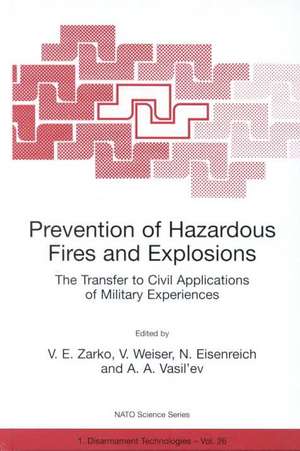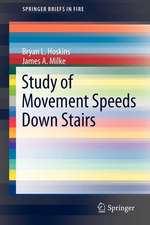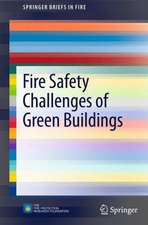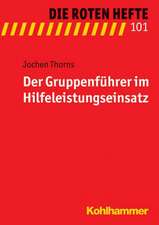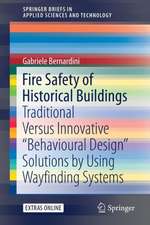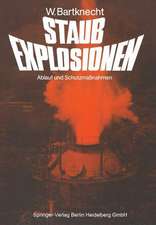Prevention of Hazardous Fires and Explosions: The Transfer to Civil Applications of Military Experiences: NATO Science Partnership Subseries: 1, cartea 26
Editat de V.E. Zarko, V. Weiser, N. Eisenreich, A.A. Vasil'even Limba Engleză Hardback – 31 mai 1999
| Toate formatele și edițiile | Preț | Express |
|---|---|---|
| Paperback (1) | 644.18 lei 6-8 săpt. | |
| SPRINGER NETHERLANDS – 31 mai 1999 | 644.18 lei 6-8 săpt. | |
| Hardback (1) | 650.86 lei 6-8 săpt. | |
| SPRINGER NETHERLANDS – 31 mai 1999 | 650.86 lei 6-8 săpt. |
Din seria NATO Science Partnership Subseries: 1
- 15%
 Preț: 643.65 lei
Preț: 643.65 lei - 18%
 Preț: 949.23 lei
Preț: 949.23 lei - 18%
 Preț: 951.14 lei
Preț: 951.14 lei - 18%
 Preț: 950.96 lei
Preț: 950.96 lei - 18%
 Preț: 1226.42 lei
Preț: 1226.42 lei -
 Preț: 392.97 lei
Preț: 392.97 lei - 18%
 Preț: 944.36 lei
Preț: 944.36 lei - 18%
 Preț: 1227.04 lei
Preț: 1227.04 lei - 18%
 Preț: 1220.26 lei
Preț: 1220.26 lei - 18%
 Preț: 947.35 lei
Preț: 947.35 lei - 18%
 Preț: 952.09 lei
Preț: 952.09 lei - 18%
 Preț: 955.56 lei
Preț: 955.56 lei - 15%
 Preț: 643.65 lei
Preț: 643.65 lei - 18%
 Preț: 947.67 lei
Preț: 947.67 lei - 18%
 Preț: 1111.97 lei
Preț: 1111.97 lei - 18%
 Preț: 1230.66 lei
Preț: 1230.66 lei - 5%
 Preț: 2125.27 lei
Preț: 2125.27 lei - 18%
 Preț: 949.23 lei
Preț: 949.23 lei - 15%
 Preț: 640.37 lei
Preț: 640.37 lei - 15%
 Preț: 650.37 lei
Preț: 650.37 lei - 18%
 Preț: 1225.16 lei
Preț: 1225.16 lei -
 Preț: 391.40 lei
Preț: 391.40 lei - 18%
 Preț: 945.14 lei
Preț: 945.14 lei - 5%
 Preț: 1407.87 lei
Preț: 1407.87 lei -
 Preț: 398.15 lei
Preț: 398.15 lei -
 Preț: 390.46 lei
Preț: 390.46 lei
Preț: 650.86 lei
Preț vechi: 765.72 lei
-15% Nou
Puncte Express: 976
Preț estimativ în valută:
124.54€ • 130.50$ • 102.96£
124.54€ • 130.50$ • 102.96£
Carte tipărită la comandă
Livrare economică 12-26 aprilie
Preluare comenzi: 021 569.72.76
Specificații
ISBN-13: 9780792357681
ISBN-10: 079235768X
Pagini: 360
Ilustrații: X, 360 p.
Dimensiuni: 155 x 235 x 22 mm
Greutate: 0.71 kg
Ediția:1999
Editura: SPRINGER NETHERLANDS
Colecția Springer
Seria NATO Science Partnership Subseries: 1
Locul publicării:Dordrecht, Netherlands
ISBN-10: 079235768X
Pagini: 360
Ilustrații: X, 360 p.
Dimensiuni: 155 x 235 x 22 mm
Greutate: 0.71 kg
Ediția:1999
Editura: SPRINGER NETHERLANDS
Colecția Springer
Seria NATO Science Partnership Subseries: 1
Locul publicării:Dordrecht, Netherlands
Public țintă
ResearchCuprins
1. Review on explosion events - a comparison of military and civil experiences.- 2. Explosions caused by fires at high explosives production.- 3. Prediction of large scale fire behavior using nuterial flammability properties.- 4. Use of modem composite materials of the chemical heat accumulator type 1 for fire protection and fire extinguishing.- 5. Test method for ranking the fire properties of materials in space based facilities.- 6. From rocket exhaust plume to fire hazards - methods to analyse radiative heat flux.- 7. A review of computational fluid dynamics (CFD) modelling of gas explosions.- 8. Detonation hazards of gaseous mixtures.- 9. Evaluation of hazard of spray detonation.- 10. Dispersion-initiation and detonation of liquid and dust aerosols - experiences derived from military fuel-air explosives.- 11. Hydrogen fire and explosion safety of atomic power plants.- 12. Hydrogen accidents and their hazards.- 13. Thin layer boilover of pure or multicomponent fuels.- 14. Industrial accident modelling: consequences and risk.- 15. The problems of porous flame-arresters.- 16. Ignition and extinction of solid propellants by thermal radiation.- 17. An assessment of ignition hazard for shielded energetic materials and its relation to flammable chemicals.- 18. Application of high energy materials for commercial use — the Indian scene.- 19. Modelling of fire effects on equipment engulfed in a fire.- 20. Mathematical modeling of catastrophic explosions of dispersed aluminum dust.- 21. Characteristics and applicability of radiothermal location system for the purpose of fire detection in Chernobyl NPP area.- 22. Limiting conditions of forest fires spreading and elaboration of the new methods to fight them.- 23. Vortex powder method for extinguishing a fire on spoutinggas-oil wells.- 24. Nanosize electro-explosion powders: assessment of safety in the production and application.- 25. Cold gas generators: multiple use in hazardous situations.- 26. Fast response fire extinguishing systems based on military equipment.- 27. On near-limiting mechanisms of catastrophic explosions penetrating through channels.
